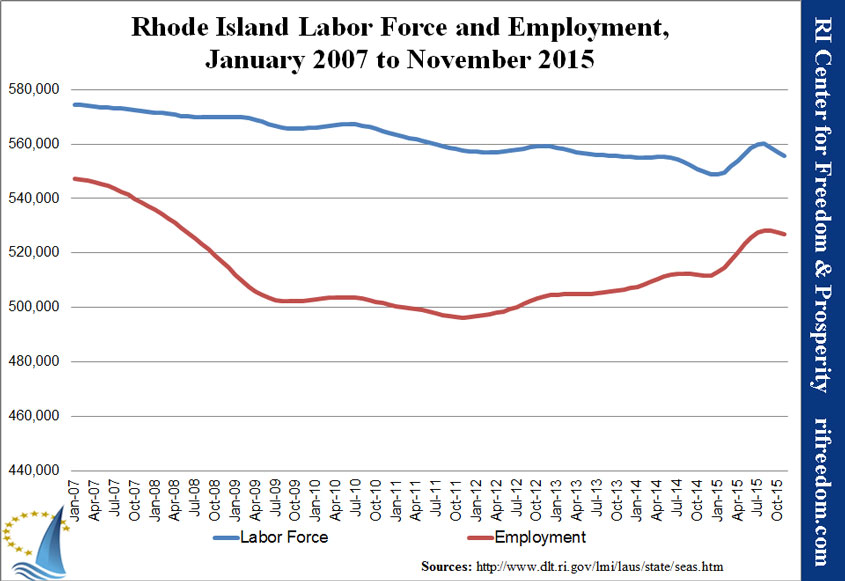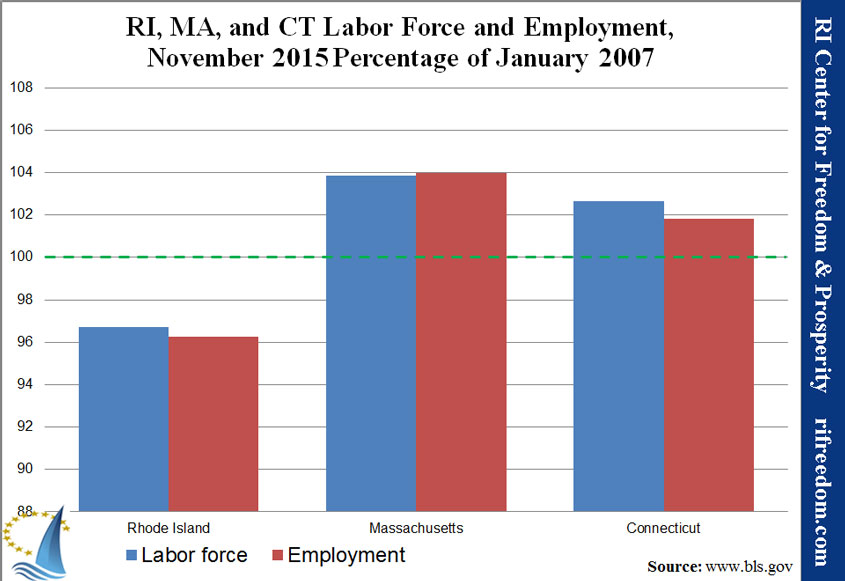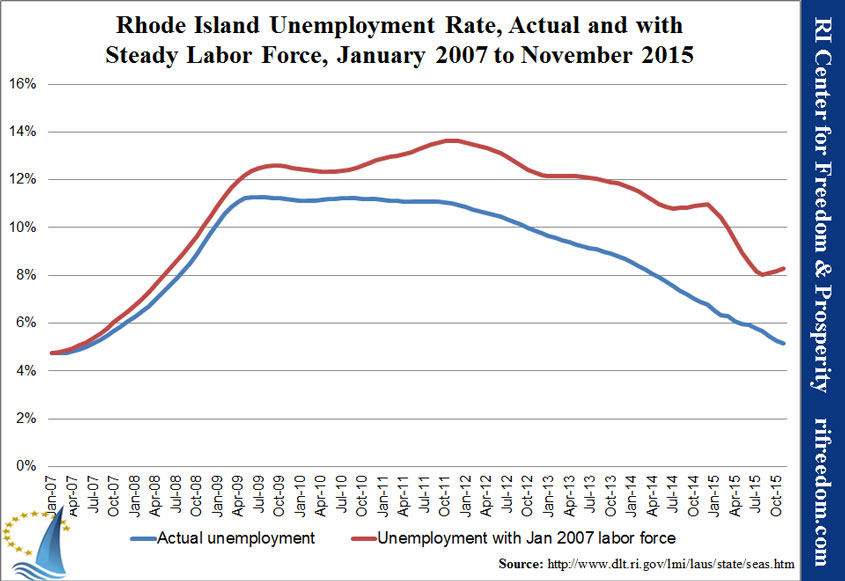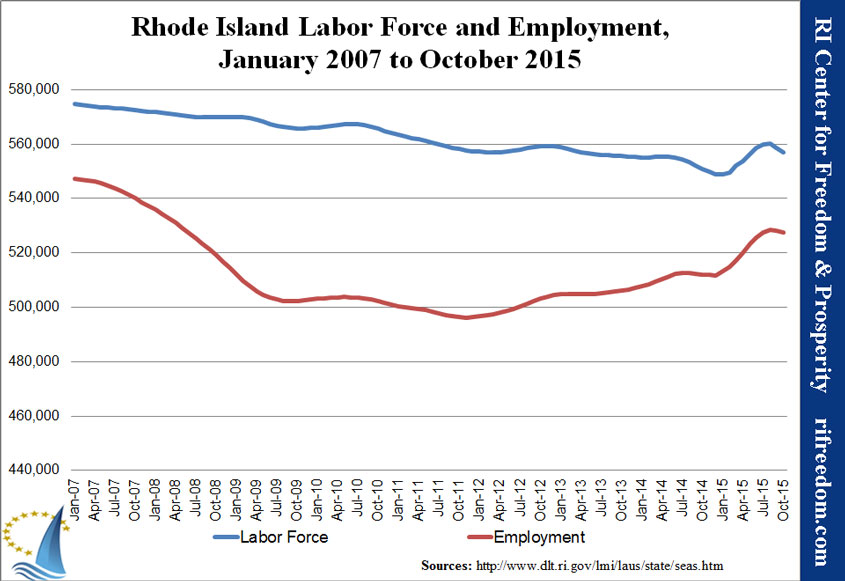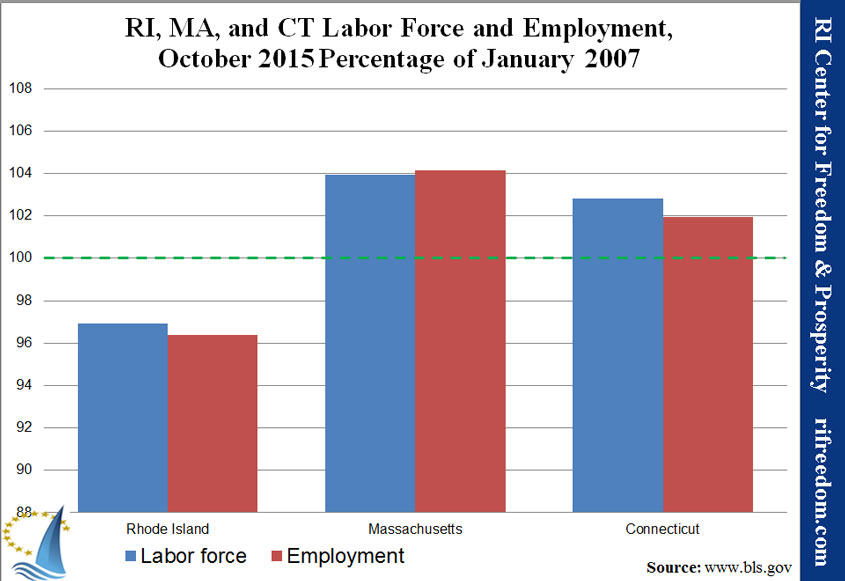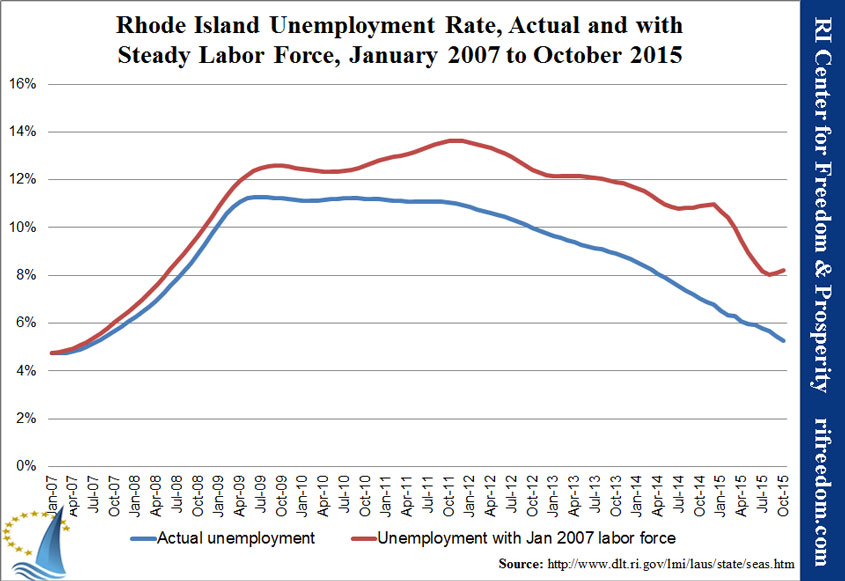RI General Assembly 2015 Session Freedom Index
/in Blog, News, Recent Posts, Studies and Reports, Transparency/by RI Center for FreedomSTATEMENT: Senate 11 Election, State House Rally Prove Supporting Tolls is Political Suicide
/in Infrastructure, Recent Posts, Taxes/by RI Center for FreedomSTATEMENT: Center Supports STOP TOLLS RI Rally. Concerns re. Big-Dig Type Cost Over-runs
/in Infrastructure, Policy, Recent Posts/by RI Center for FreedomNOVEMBER JOBS SNAPSHOT: Lower Unemployment Rate Paints Inaccurate Picture
/in Jobs, Recent Posts/by RI Center for FreedomFOR IMMEDIATE RELEASE
December 21, 2015
RI Unemployment Rate Again Paints False Picture
Center to publish new Jobs & Opportunity Index in 2016
Providence, RI — For the second month in a row, the November unemployment rate for Rhode Island appears to paint an incomplete and misleading snapshot of the true jobs and economic picture in the state, according to a monthly analysis by the nonpartisan RI Center for Freedom & Prosperity. As in October, the lower state unemployment rate, seemingly a positive, was the result of two negative pieces of data: lower overall employment and a smaller labor force (a result of people giving up looking for work).
While the U.S. Bureau of Labor Statistics (BLS) measures six levels of unemployment, U1 thru U6, it is only the U3 unemployment rate that is the basis for the official monthly unemployment rate: U3 narrowly measures the number of unemployed people as a percentage of the labor force. However, U3 is largely dependent on labor force size; so in keeping with the trend of recent months in Rhode Island, when the labor force drops, usually considered a negative economic indicator, it generally produces a lower U3 unemployment rate, which is conversely seen as a positive.
In November of 2015, Rhode Island’s unemployment rate dropped to 5.2%, from 5.3% in the prior month. But, similar to October data – employment levels actually dropped (by 770 people) and 1,461 Rhode Islanders gave up looking for work, thus shrinking the labor force.
“To hear politicians crow about our state’s lower unemployment rate is misguided,” said Research Director Justin Katz, “two losses don’t make a real gain; and this pattern has persisted for years. There’s much more going on in our state that lawmakers should be aware of.”
Among the specific findings in the November analysis:
- RI’s unemployment rate would have increased to 8.3% if the state had maintained the same size labor force at it had before the recent recession
- RI lags far behind its MA and CT neighbors in terms of recovering its employment and labor force levels since before the recent recession
For graphs, charts and a more detailed analysis of Rhode Island’s November employment status click here.
New JOI Index in 2016: In order to account for this labor force vs unemployment rate contradiction and to provide Rhode Islanders with a broader and more accurate picture of the state’s actual jobs market, in Q1 of 2016, the Center plans to publish a monthly Jobs & Opportunity Index, which will incorporate other BLS unemployment categories and which will also measure the size and scope of the state’s private sector as compared with the size and scope of state government.
Rhode Island Employment Snapshot, November 2015: Expected Down Note as Last Report of the Year
/in Blog, Jobs, Recent Posts/by Justin Katz[Click here for the printable one-page PDF of this post.]
The trend that has come to define Rhode Island’s employment picture in 2015 (indeed, since the end of the recession) continued for the final Bureau of Labor Statistics (BLS) report for the year. In November, Rhode Island’s unemployment rate dropped to 5.2%, from 5.3% in October. That’s 28 straight months of decreases in the rate of at least one-tenth of one percent. As usual, however, the positive rate resulted from two bits of negative data. Employment actually dropped by 770 people, but 1,461 Rhode Islanders stopped looking for work.
The first chart shows that November’s results continued a downturn in Rhode Island’s underlying employment results. Although the annual revision due next month may shift the picture quite a bit, the state’s labor force (those employed or actively looking for work) is nearly back where it was in the middle of 2014, erasing both a sharp downturn at the end of that year and an even bigger increase for the first half of this year.
November was another month in which New England was almost unique in losing employment, with all six states bucking a national trend of increases. The columns in the second chart are consequently smaller for both Massachusetts and Connecticut, this month, but Rhode Island remains the only Southern New England state well below its January 2007 level of employment and labor force.
The third chart illustrates the fundamental problem of the official unemployment rate. The red line shows what Rhode Island’s unemployment rate would have been if the labor force had not shrunk since January 2007. As of November, the unemployment rate would actually be going back up, having never dipped below 8%. For November, it would have increased to 8.3%.
Statement: Ocean State Jobs Picture Not As Rosy As It Seems
/in Issues, Jobs, News, Recent Posts/by RI Center for FreedomFOR IMMEDIATE RELEASE
November 25, 2015
RI Employment Picture Tainted by Dwindling Labor Force
Center to publish new quarterly jobs index in 2016
Providence, RI — The traditional monthly unemployment rate, widely reported by most news outlets, often paints an incomplete and misleading snapshot of the true jobs and economic picture in the state, according to a monthly analysis by the nonpartisan Rhode Island Center for Freedom & Prosperity.
While the U.S. Bureau of Labor Statistics (BLS) measures six levels of unemployment, U1 thru U6, it is only the U3 unemployment rate that is regularly cited: U3 narrowly measures the number of unemployed people as a percentage of the labor force. However, U3 is largely dependent on labor force size; so when the labor force drops, usually considered a negative economic indicator, it generally produces a lower U3 unemployment rate, which is conversely seen as a positive.
For instance, in October of 2015, Rhode Island’s unemployment rate dropped, from 5.4% in September, to 5.3% in October. But, as has often been the case, that apparent positive outcome is the result of two negative trends; employment levels actually dropped (by 630 people) and 1,636 Rhode Islanders gave up looking for work, thus shrinking the labor force.
“The falling unemployment rate is the one statistic that Rhode Island politicians like to cite as evidence of economic progress,” said Research Director Justin Katz, “but two losses don’t make a gain. If our state’s poor business climate hadn’t driven so many people out of its labor force since the recession, unemployment would never have dipped below 8%, and it would be on its way back up, right now.”
Among the specific findings in the October analysis:
- RI’s unemployment rate would be 8.2% if the state had maintained the same size labor force at it had before the recent recession
- RI lags far behind its MA and CT neighbors in terms of recovering its employment and labor force levels since before the recent recession
For graphs, charts and a more detailed analysis of Rhode Island’s October employment status click here.
In order to account for this contradiction and to provide Rhode Islanders with a broader and more accurate picture of the state’s actual jobs market, in Q1 of 2016, the Center plans to publish a quarterly Jobs Opportunity Index which will incorporate all six BLS Unemployment categories. The other BLS U-categories more broadly take into account such measurements as underemployed and discouraged workers; people who are willing to work, but for whatever reason, have not looked for work or who are working only on a part-time basis – yet who do not fit the narrow U3 definition of “unemployed”.
Media Contact:
Justin Katz
401-835-7156 | jkatz@oceanstatecurrent.com
Mike Stenhouse, CEO
401.429.6115 | info@rifreedom.org
About the Center
The nonpartisan RI Center for Freedom & Prosperity is Rhode Island’s premiere free-enterprise research and advocacy organization. The mission of the 501-C-3 nonprofit organization is to return government to the people by opposing special-interest politics and advancing proven free-market solutions that can transform lives by restoring economic competitiveness, increasing educational opportunities, and protecting individual freedoms.
Rhode Island Employment Snapshot, October 2015: Two Losses Don’t Make a Gain
/in Blog, Jobs, Recent Posts/by Justin Katz[Click here for the printable one-page PDF of this post.]
For yet another month, Rhode Island’s unemployment rate dropped, from 5.4% in September, to 5.3% in September, according to data from the federal Bureau of Labor Statistics (BLS). And for yet another month, that positive outcome resulted from two negative results. Employment actually dropped by 630 people, but 1,636 Rhode Islanders gave up looking. Meanwhile, jobs based in the state increased by a mere 100 after a sizable drop the month before.
The first chart shows that October’s results represent a turnaround in Rhode Island’s employment fortunes. (Although the likelihood remains that the year’s early increases will be revised away.) The trend of large early gains which are revised downward substnatially has been established for several years, now.
Every state in New England lost employment, in October, so the columns in the second chart are smaller for both Massachusetts and Connecticut, this month, but Rhode Island remains the only Southern New England state well below its employment and labor force as of January 2007.
The third chart is the most illustrative of the skepticism that readers should have when watching the unemployment rate, the red line shows what Rhode Island’s unemployment rate would have been if the labor force had not shrunk since January 2007. As of October, the unemployment rate would actually be going back up, having never dipped below 8%. For October, the unemployment rate would be 8.2%.
Center Receives Farm Bureau Award For Anti-RhodeMap RI Work
/in News, Organizational, Property Rights, Recent Posts/by Mike StenhouseCenter Feted for Raising Awareness about
HUD & Federal Intrusion
November 19, 2015, Alpine Country Club in Cranston, RI
The RI Center for Freedom for Prosperity Accepts the RI Farm Bureau’s 2015 Navigator Award
The award recognized the Center “for being the faithful and undaunting watchdog and protector of freedom and prosperity granted to all Rhode Islanders,” in raising awareness about the federal HUD agenda implemented in RI called RhodeMap RI, which could threaten the property rights and values of farmers throughout the state, as well as other private property owners.
In accepting the award on behalf of the Center’s board and staff, CEO Mike Stenhouse thanked the Bureau for standing with other concerned citizens against the intrusive federal power and land grab by HUD. Stenhouse drew parallels to a topic raised earlier in the evening by a speaker from the American Farm Bureau, about how the federal EPA has similarly been seeking to control more and more local land through its controversial, so-called Clean Water Act, which would further restrict land use for many farmers.
 …
… 

Stenhouse added that private property ownership and rights to develop land are fundamental precepts of America’s free-enterprise system, and that the Center would continue to fight against federal and state mandates that would restrict those freedoms.
Also receiving Navigator awards were: Representative Patricia Morgan (R, D26) for her work in fighting proposed tolls, which would directly impact farm trucks; and Senator Susan Sosnowski (D, D38) for her legislative support of farmer’s issues.
The RI Farm Bureau is the voice of thousands of Rhode Island farmers when it comes to dealing with issues that impact the agriculture industry.
STATEMENT: Poor PARCC Scores Demonstrate that RI Families Need More Choices
/in Recent Posts, Youth Issues/by RI Center for FreedomSTATEMENT
November 17, 2015
One-Size-Fits-All Government Schools Not Adequately Preparing Many Students for Success in College, Career, and Life
Empowering Parents with More Choices Needed Now More Than Ever
For a more detailed analysis of RI’s PARCC scores, read the blog on The Ocean State Current
Providence, RI — The disappointing results among RI students in the recently released PARCC test scores re-enforce the need to empower families with additional educational choice options, according to a statement today from the RI Center for Freedom & Prosperity.
“Education is the civil rights issue of our time. Every parent wants an effective education for their children that prepares them for college, career, and life. When government schools fail to inspire students, it is our moral obligation to provide each and every child with an immediate and better option,” commented Mike Stenhouse, CEO for the Center. “Our proposed ESA legislation empowers parents to choose a public or private educational path for their children that will motivate and challenge them.”
The PARCC results further demonstrate that educational funding is not the primary issue. Rhode Island public schools spend among the highest per pupil in the nation, yet numerous national benchmarks place Rhode Island student performance at below average or middle of the pack.
As compared with PARCC results in Massachusetts, for example, even the Ocean State’s better performing school districts, would be just about average in the Bay State.
The Center recommends that significant reforms and immediate options are required to benefit all students.
The Center is part of the statewide Bright Today coalition advocating for an educational choice policy that would directly benefit students trapped in schools that do not adequately prepare them for a secure and successful future, by empowering parents – via Educational Scholarship Accounts (ESA) that can be used at private schools of the parents’ choice.
For more information about ESAs, visit RIFreedom.org/EdChoiceRI.
Media Contact:
Mike Stenhouse, CEO
401.429.6115 | info@rifreedom.org
About the Center
The nonpartisan RI Center for Freedom & Prosperity is Rhode Island’s premiere free-enterprise research and advocacy organization. The mission of the 501-C-3 nonprofit organization is to return government to the people by opposing special-interest politics and advancing proven free-market solutions that can transform lives by restoring economic competitiveness, increasing educational opportunities, and protecting individual freedoms.

